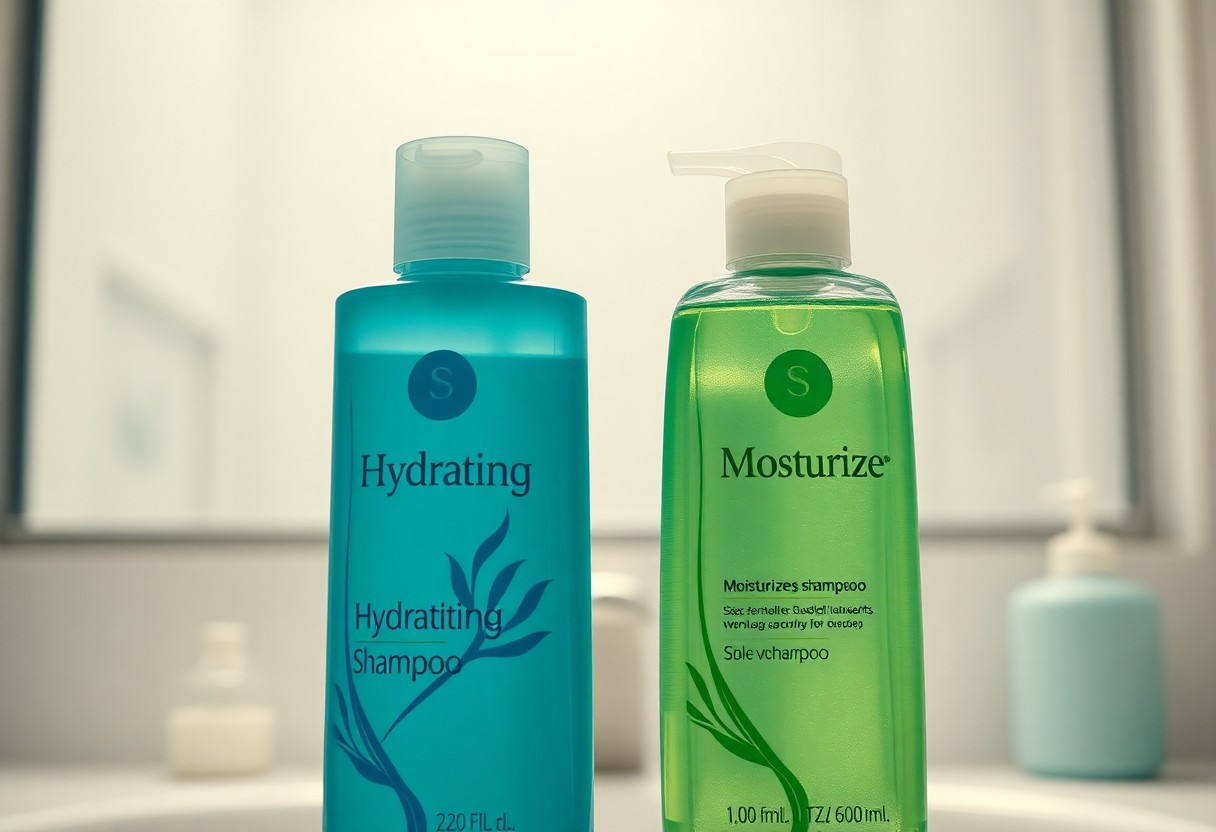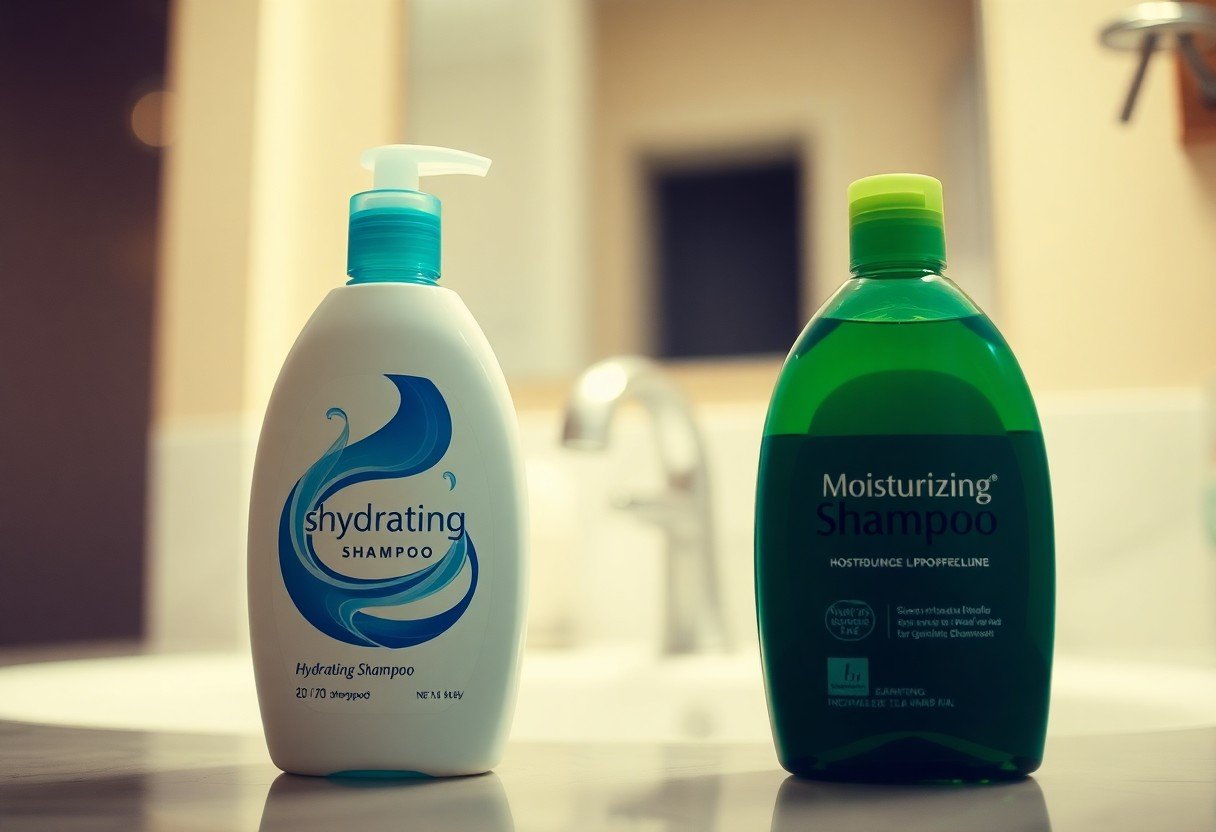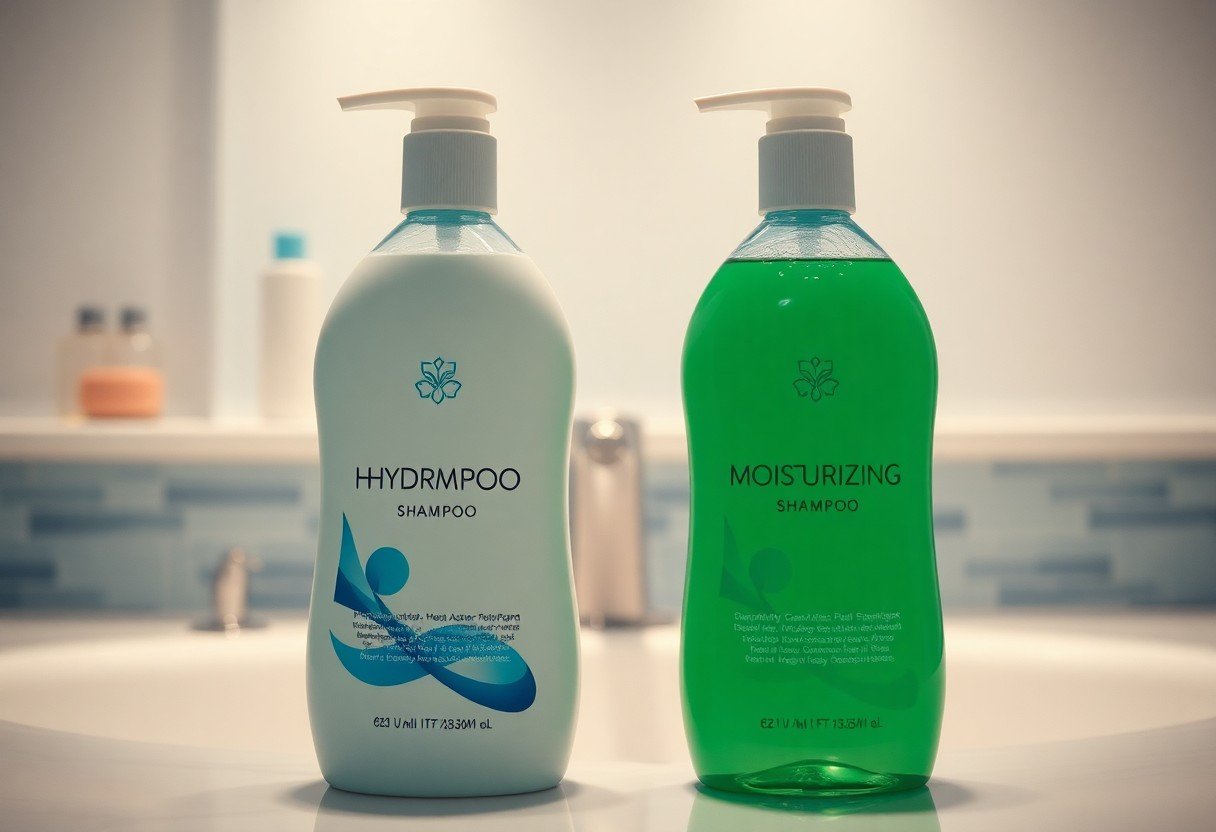There’s a common misconception that hydrating and moisturizing shampoos serve the same purpose for your hair. While both products aim to improve your hair’s health, they work in fundamentally different ways. Hydrating shampoos focus on adding water content to your hair strands, making them ideal for dehydrated and brittle hair. On the other hand, moisturizing shampoos seal in existing moisture and add oils to your hair, making them perfect for dry and damaged locks. Understanding this difference will help you choose the right product for your specific hair needs.

Understanding Hydrating Shampoo
For those dealing with dry, brittle hair, hydrating shampoo serves as your first line of defense against dehydration. These specialized formulas work by helping your hair retain water at the cellular level, preventing moisture loss during and after washing.
Definition and Purpose
To restore your hair’s natural moisture balance, hydrating shampoos penetrate the hair shaft to deliver water molecules directly into the cortex. This process helps rebuild your hair’s internal moisture barrier, making it more resistant to environmental stressors and heat styling damage.
Key Ingredients
While hydrating shampoos contain various water-binding ingredients, the most effective ones include hyaluronic acid, glycerin, and aloe vera. These humectants attract and lock moisture into your hair strands, preventing dehydration.
For instance, hyaluronic acid can hold up to 1000 times its weight in water, while glycerin creates a protective layer that seals in moisture. Natural ingredients like aloe vera provide additional benefits by soothing your scalp while maintaining optimal hydration levels. You’ll find these ingredients particularly beneficial if you have color-treated or chemically processed hair.

Understanding Moisturizing Shampoo
Some moisturizing shampoos work by creating a protective layer on your hair strands to lock in moisture and prevent water loss. These specialized formulas help repair damaged hair, reduce frizz, and make your locks more manageable. When you choose a moisturizing shampoo, you’re investing in a product that focuses on long-term hair health and moisture retention.
Definition and Purpose
To maintain healthy hair, moisturizing shampoo delivers crucial oils and emollients directly to your hair shaft. This type of shampoo is particularly beneficial for dry, damaged, or chemically treated hair. You’ll notice immediate improvements in hair texture and manageability after using these specialized formulations.
Key Ingredients
Purpose-driven ingredients in moisturizing shampoos include natural oils, glycerin, and fatty alcohols. You’ll find components like argan oil, shea butter, and panthenol, which work together to nourish your hair and improve its overall condition. These ingredients create a protective barrier that helps your hair retain moisture throughout the day.
Understanding the role of each ingredient helps you make informed choices. Ingredients like dimethicone provide instant smoothness, while natural oils penetrate deeper into the hair shaft. You should be aware that some moisturizing shampoos may contain heavy silicones which can build up on fine hair types. Natural butter and oils offer the most beneficial long-term moisturizing effects for your hair.
Differences Between Hydrating and Moisturizing Shampoo
Any confusion between hydrating and moisturizing shampoos stems from their distinct functions. Hydrating shampoos focus on infusing water into your hair, while moisturizing shampoos create a protective barrier to lock in existing moisture. You’ll find that hydrating products work best for dehydrated hair that feels brittle, whereas moisturizing formulas suit naturally dry hair types that need ongoing nourishment.
Texture and Consistency
Hydrating shampoos typically have a lighter, more water-based consistency that you’ll notice immediately. Your hair absorbs these formulas quickly, making them ideal for fine to medium hair textures. Moisturizing shampoos, in contrast, feel richer and creamier due to their oil-based ingredients, providing a more substantial feel during application.
Targeted Benefits
Texture differences in your hair determine which formula will work best. You’ll benefit from hydrating shampoo if your hair feels brittle and straw-like, while moisturizing shampoo works better when your hair feels rough and lacks natural oils. The right choice depends on identifying whether your hair needs water content or oil-based nourishment.
Shampoo selection impacts your hair’s long-term health. When you choose hydrating formulas, you’ll notice improved elasticity and bounce. Moisturizing options provide enhanced manageability and protection against environmental damage. Your hair type and current condition should guide your choice between these two specialized formulations.
How to Choose the Right Shampoo for Your Hair Type
To select the perfect shampoo, you need to understand your hair type and its specific requirements. Whether you have dry, oily, or combination hair, choosing the right formula can make a significant difference in your hair’s health and appearance. Consider factors like scalp condition, hair texture, and any specific concerns such as dandruff or color treatment.
Assessing Your Hair Needs
Clearly identifying your hair’s current state is important for selecting the appropriate shampoo. Examine your hair’s:
- Moisture level
- Scalp condition
- Damage extent
- Texture type
Assume that your hair needs may change with seasons and treatments.
Tips for Selection
Your shampoo selection should align with your hair’s specific requirements. Consider these factors:
- Check for natural ingredients
- Look for targeted solutions
- Verify pH balance
- Review sulfate content
Assume that the most expensive option isn’t always the best choice.
To make the most informed decision, always test new shampoos for at least two weeks. Pay attention to how your hair responds to different formulations and ingredients. Consider using clarifying shampoo occasionally to remove buildup, and don’t hesitate to combine different products for optimal results. Assume that finding your perfect shampoo might require some trial and error.
Tips for Using Hydrating and Moisturizing Shampoos
Many hair care experts recommend following specific guidelines to maximize the benefits of your hydrating and moisturizing shampoos. Focus on applying the product to your scalp and roots first, then work your way down to the ends. Always use lukewarm water as hot water can strip your hair of natural oils. Though the type of shampoo you choose matters, proper application technique and frequency are equally important for achieving optimal results.
Application Techniques
You should start by thoroughly wetting your hair with lukewarm water. Apply a quarter-sized amount of shampoo to your palms and gently massage it into your scalp using circular motions. Work the product down the length of your hair, paying special attention to the ends. Avoid rough handling or excessive scrubbing, as wet hair is more susceptible to damage.
Frequency of Use
You need to adjust your washing schedule based on your hair type and lifestyle. For normal to dry hair, washing 2-3 times per week is typically sufficient. If you have particularly oily hair, daily washing with a gentle hydrating shampoo might be necessary. Over-washing can disrupt your scalp’s natural moisture balance, so pay attention to how your hair responds.
It’s worth noting that seasonal changes and environmental factors may require you to modify your washing frequency. During winter months, you might need to wash less frequently to prevent dryness, while summer activities might necessitate more frequent washing. If you notice your scalp becoming itchy or your hair feeling weighed down, consider adjusting your routine.

Factors Influencing Shampoo Effectiveness
Despite using the right type of shampoo, several factors can impact how well it works for your hair. The interaction between product ingredients, hair porosity, and environmental conditions plays a vital role in determining results. Your hair care routine, washing frequency, and application technique can significantly affect how well the shampoo performs. The success of your hair care regimen depends on understanding these elements and adjusting them accordingly.
Hair Type
With different hair textures and structures, your natural hair type greatly influences how your hair responds to hydrating or moisturizing shampoos. You’ll notice that fine hair may become weighed down by heavy moisturizing formulas, while coarse hair typically requires more intensive hydration. The key is matching your hair’s unique characteristics to the appropriate product concentration.
Environmental Considerations
Effectiveness of your shampoo varies significantly based on climate conditions and environmental factors. You’ll find that humidity levels, sun exposure, and water quality directly impact how your hair responds to different formulations. The seasonal changes require you to adjust your hair care routine to maintain optimal results.
Understanding your local environment helps you make better choices for your hair care routine. Hard water can reduce shampoo effectiveness and leave mineral buildup on your hair. High humidity may cause frizz, while dry climates can increase static and brittleness. You might need to use different products during summer and winter months to protect your hair from changing weather conditions.
- Water hardness and quality
- Humidity levels
- Sun exposure
- Seasonal changes
- Indoor heating and cooling
Summing up
On the whole, understanding the distinction between hydrating and moisturizing shampoos can help you make better choices for your hair care routine. While hydrating shampoos work by adding water to your hair strands and increasing water content from within, moisturizing shampoos create a protective barrier that locks in existing moisture and prevents water loss. Your hair type and specific needs will determine which option works best – choose hydrating shampoos for dehydrated hair that lacks water, and moisturizing formulas when your hair needs help retaining its natural oils and moisture.
FAQ
Q: What are the main differences between hydrating and moisturizing shampoo?
A: Hydrating shampoo adds water to the hair shaft and scalp, while moisturizing shampoo creates a protective barrier to lock in existing moisture. Hydrating products contain ingredients like hyaluronic acid and glycerin, whereas moisturizing shampoos typically include oils and butters. Hydrating shampoo works from the inside out, while moisturizing shampoo works from the outside in.
Q: Which type of hair benefits most from hydrating shampoo?
A: Hydrating shampoo works best for dehydrated hair that feels brittle and lacks water content. It’s particularly effective for fine or thin hair that gets weighed down easily by heavy moisturizing products. People with chemically treated hair or those living in dry climates will also benefit significantly from hydrating shampoos.
Q: When should I use moisturizing shampoo instead of hydrating shampoo?
A: Moisturizing shampoo is ideal for thick, coarse, or naturally dry hair types. It’s especially beneficial during winter months or in humid conditions when hair needs extra protection. If your hair is prone to frizz, breakage, or split ends, moisturizing shampoo can provide the necessary nourishment and protection to maintain healthy strands.
Q: Can I use both hydrating and moisturizing shampoos together?
A: Yes, you can alternate between both types of shampoo to achieve optimal hair health. For example, use hydrating shampoo during your first wash to add water content to your hair, then follow up with moisturizing shampoo to seal in that hydration. This combination approach can be particularly effective for damaged or processed hair.
Q: How can I identify if my hair needs hydration or moisturizing?
A: To determine which type you need, spray a small amount of water on your dry hair. If it absorbs quickly, your hair needs hydration. If the water beads up and rolls off, your hair needs moisturizing. Additionally, hair that feels brittle and straw-like typically needs hydration, while hair that feels dry and frizzy usually needs moisturizing.

